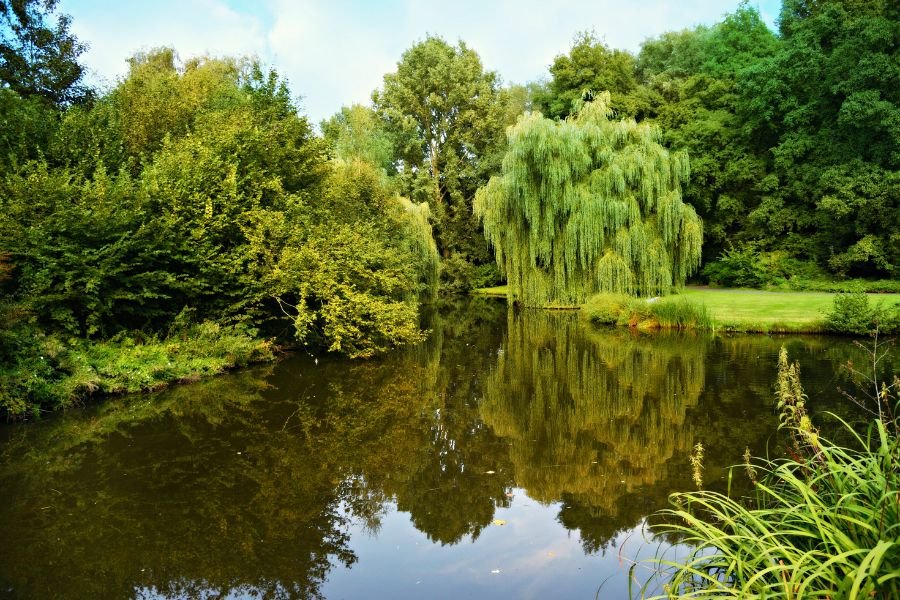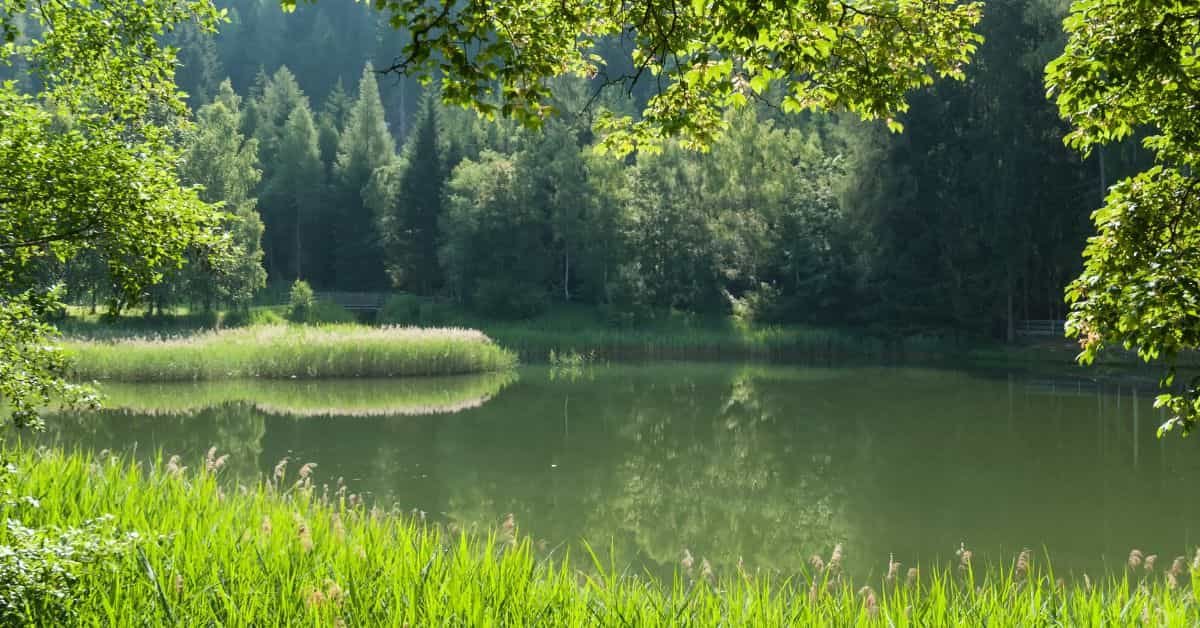Ecosystems are formed by the interaction of plants, animals, and microorganisms with their abiotic environment. A pond ecosystem is an ecosystem in a water body that consists of producers, consumers, decomposers, and their surroundings.
What is a pond ecosystem?

A pond ecosystem is one kind of aquatic ecosystem consisting of both biotic and abiotic organisms or substances and their surroundings. A pond ecosystem is a freshwater ecosystem in which organisms rely on one another and on the water for nutrients and survival.
Ponds are shallow bodies of water (12-15 feet) where sunlight can reach the bottom and grow plants. A pond ecology is a temporary or permanent freshwater ecosystem that comprises aquatic plants and animals interacting with each other and the environment.
Types of pond ecosystem:

| Garden pond ecosystems | Garden pond ecosystems are man-made artificial pond ecosystems with ornamental plants and animals. |
| Salt pond ecosystems | Salt pond ecosystems are brackish, seaside ecosystems. Waterlogging causes these. These are also in beach rock pools. Brackish water can support marine life. |
| Freshwater pond ecosystems | Rainfall or soil saturation from continuous rain form freshwater pond ecosystems. River water flowing into a deep depression can also form them. Freshwater fishes, amphibians, crustaceans, and other animals live in these ecosystems. |
| Venereal pond ecosystems | Venereal pond ecosystems form during heavy rains when water collects in depressions in the ground. Seasonally, they become deserts. |
| Mountain pond ecosystems | Mountain ponds are naturally formed. Shifting rocks and melting snow create these ponds. They house endangered aquatic species. |
The features of a pond ecosystem:
Pond ecosystem features include:
- The pond is stagnant.
- The pond ecosystem has natural or artificial borders.
- Littoral, limnetic, profundal, and benthic are the pond’s zones.
- Different levels of biotic components in the pond prevent survival competition.
- Bottom level: scavengers and decomposers, middle level: fish. Small animals and insects are protected by the pond’s plants.
- Pond ecosystems vary in size.
The freshwater pond ecosystem

The pond ecosystem includes:
- The pond bottom lacks oxygen and light. Here, decomposers and scavengers eat dead matter.
- Midwater is mostly fish. The pond bottom and surface both have food. Stickleback fish, water fleas, and dragonfly nymphs breathe through skin or gills.
- Pond surface animals breathe through gills, skin, or lungs. Oxygen and light abound. Ducks, boatmen, midge larvae, and tadpoles live here.
- Pond margin plants shelter insects and small animals like frogs. Marsh marigolds thrive in light and oxygen.
- Kingfishers and dragonflies are common atop ponds.
Abiotic substances:
There are two types of abiotic substances found in the pond ecosystem, i.e., physical substances and chemical factors.
Physical substances:
- Light
- Air
- Water
- Mud
- Sand etc.
Chemical factors:
- CO2
- S8
- P4
- N2
- O2
- Protein
- Carbohydrates
- Lipid
- Humus
- Minerals
Biotic substances:
- Autotrophs
- Heterotrophs
1. Autotrophs:
Green plants and chemosynthetic organisms are the autotrophs in a pond ecosystem. They are mainly the producer group. There are two types of autotrophs found in a pond.
Rooted plants with floating branches:
- Ex – Nympheae, Nelumbo, etc.
Free-floating plants:
- Ex – Pistia, Limma, etc.
2. Heterotrophs:
Organisms that cannot produce their food and are dependent on other for others for their food are called heterotrophs. They are generally called consumers. There are two types of consumers. There are two types of consumers. They are –
- Primary consumers
- Secondary consumers
Primary consumers: Primary consumers are animals that feed on primary producers. They are divided into3 categories –
- 1st level consumer: Consumers eat from the producer directly. Ex – Mosquito larvae
- 2nd level consumer: Consumers those feed on the first level consumer. Eg – small fishes
- 3rd level consumer: Consumers those feed on both 1st & 2nd level consumers. Ex-Big fishes
Secondary consumers:
They are also called decomposers. They break down dead plant and animal bodies and release nutrients. So we can say that a pond ecosystem is the best example of an aquatic ecosystem.
Ecological classification of freshwater organisms:
Ecologically freshwater organisms are divided into three categories –
- Food chain (energy flow based on the niche)
- Life form
- Zone of habitat
Food chain:
The transfer of food energy from the producers through a series of the organism by repeated eating and being eaten by others is called a food chain. Organisms are divided into three categories based on their position in a food chain –
- Producer
- Consumer
- Decomposer
Producer:
Organisms that can make their food in the presence of sunlight and chlorophyll are called producers.
Algae and aquatic plants like Azolla, Hydrilla, Potamogeton, Pistia, Wolffia, Lemna, Eichhornia, Nymphaea, Jus siaea, etc. are the principal producers in pond or lake ecosystems and they are floating, suspended or rooted.
Photosynthesis converts light into chemical energy in green plants. All creatures use food’s chemical energy. All living organisms respire oxygen produced by photosynthesis.
Example – Phytoplankton
Consumer:
Organisms that can’t make their food and depends on other to feed themselves are called consumers.
Frogs, fish, and other aquatic animal tadpoles eat green plants and algae in a pond habitat. Secondary consumers eat herbivorous aquatic creatures. Secondary consumers include frogs, fish, snakes, and crabs. Water birds, turtles, etc. are the pond’s highest-order consumers.
There are 3 types of consumers –
- Primary consumer: They feed on the producer directly. Example – Small fish, Mosquito larvae, etc.
- Secondary consumer: They feed on the primary consumer. Example – Small fishes
- Tertiary consumer: They are the topmost consumer in a food chain. Example-Large fish.
Decomposers:
They decompose the body of plants and animals. Bacteria and fungus attack deceased aquatic plants and animals and transform complex organic molecules into simpler inorganic chemicals and elements. Chemical components released by decomposers are used to nourish green plants.
Example – Bacteria, algae.
Life form in water:
Organisms in water may be classified as to their life forms.
- Benthos
- Plankton
- Periphyton
- Neuston
- Nekton
Benthos:
Organisms that live in the sediments of a water body are called benthos. Example – Pila, Unio, etc.
Plankton:
Floating organisms whose movement is more or less dependent on water current are called plankton. Usually, zooplankton is larger than phytoplankton. So, plankton can be divided into two based on their size.
- Net plankton
- Nano plankton
Net plankton:
Net plankton is those which can be caught by a net. Ex – Daphnia, Cyclops, etc.
Nano plankton:
Nano plankton is those which are too small to catch by a net. Ex – Various algae
Periphyton:
Organisms attached to stems and leaves of rooted plants are called periphyton. Ex – Snail
Nekton:
Swimming organisms that can navigate themselves at will. Ex – amphibians
Neuston:
Organisms resting or swimming on the surface. Ex – Richteriella
Zone of habitat in a pond ecosystem:
Organisms can be classified as their niche or sub-habitat. In the pond or lake, 3 zones are generally evident.
- Littoral zone
- Limnetic zone
- Profound zone
Littoral zone:
The shallow water near the Shore where light can easily penetrate to the bottom is called the littoral zone. Various macrophytes are dominant here.
Limnetic zone:
The open water area where light does not generally penetrate to the bottom. Plankton, nekton, and sometimes neuston are dominant here.
Profound zone:
The bottom and the deep water area of a lake where light cannot penetrate. Benthos are dominant here. This is the ecological classification of freshwater organisms.
The importance of a pond ecosystem:
The pond ecosystem is important. They support more biodiversity than any other freshwater habitat. Wetland plants and animals live in ponds. Pond combines three food webs. They don’t just quench thirst or provide shelter; they also beautify nature. It calms and connects us to nature.
- Aquatic plants absorb pollutants and heavy metals, improving water quality.
- Shoreline plants absorb nitrogen and phosphorus, preventing algal blooms and maintaining oxygen. Aquatic plants absorb animal wastes to reduce plant nutrients and prevent algae growth.
- Plants and consumers in different pond strata interact to preserve biodiversity. Mountain ponds help endangered animals.
- The pond ecosystem provides water to non-pond species.
- Pond ecosystems beautify nature by housing ornamental flowering plants.
- Stratification determines the distribution of pond species. It lessens species competition.
Wrapping It Up
The pond ecosystem includes submerged, emerged, and free-floating plants, algae, and animal species. Stratification determines light, oxygen, minerals, etc. availability at different pond depths. Abiotic factors affect consumer and decomposer distribution.
